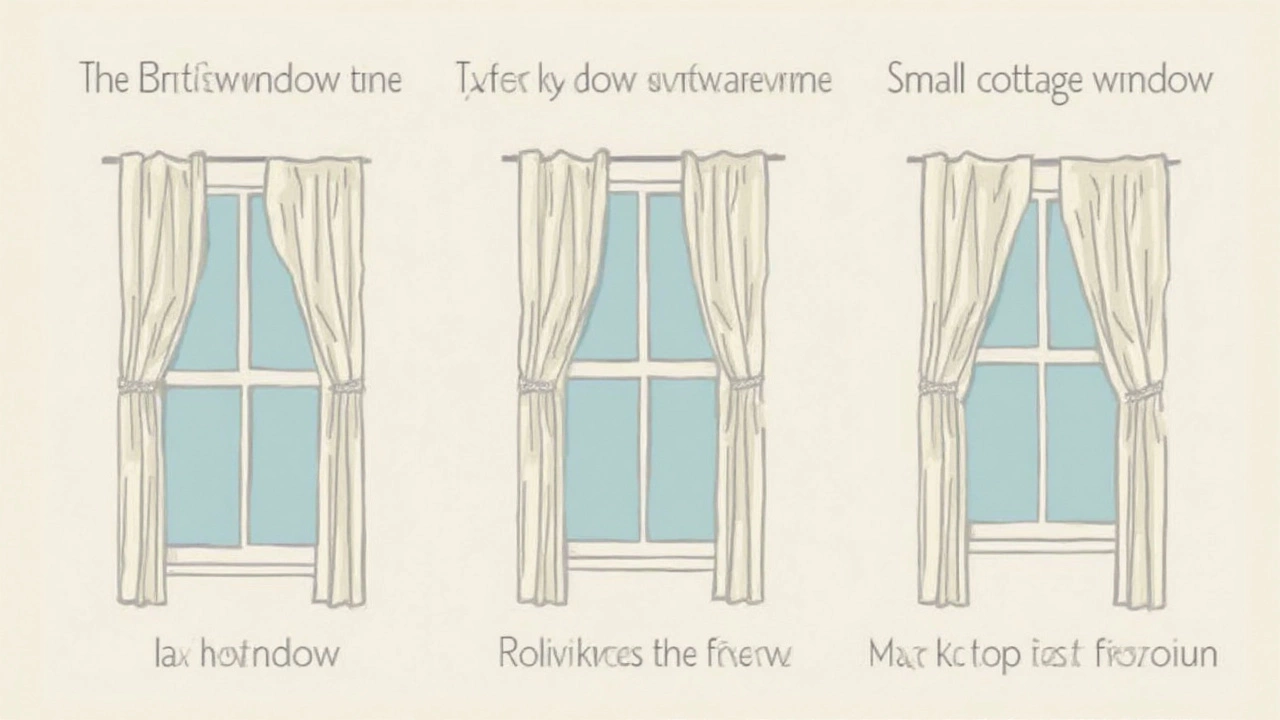Curtains: How Far Down Should They Hang for the Best Look?

So, how far down should curtains hang? A lot of people just guess—or go with whatever length is on sale. Turns out, those extra inches (or lack of them) can totally change how your room feels. Curtains that are too short scream unfinished. Ones that puddle too much risk looking sloppy (and let’s be real, they pick up dust).
Here’s what matters: most pros suggest your curtains come right down to the floor, or just barely touch it. Some folks love a bit of puddle—an extra inch or two bunched on the ground—for that cozy, dramatic look. But if you don’t want to be dragging the vacuum over fabric every week, stopping just above the floor keeps things clean and polished.
Before you buy or hem anything, measure twice—literally from the spot where your rod will hang down to the floor, not just the top of the window. Window height and floor type can both mess with your plans, so don’t eyeball it. The right curtain length can make your ceilings seem taller and your whole room more pulled together.
- Standard Curtain Lengths Explained
- Why Curtain Length Changes Everything
- Floor-Grazing vs. Floating: Pros and Cons
- How to Measure for The Perfect Drop
- Common Mistakes (and How to Avoid Them)
- Finding the Right Length for Your Room
Standard Curtain Lengths Explained
When you hear talk about curtain length, stores and guides usually mention four main sizes. These are called sill, apron, floor, and puddle lengths. They fit different spaces and give a totally different feel to each room.
- Sill length: Curtains stop just above the window sill. Usually about 63 inches tall. People use this in kitchens or bathrooms where long fabric would just get in the way.
- Apron length: These hang 4-6 inches below the window sill, usually landing around 72 inches. Great for radiators or furniture that sits right under your window.
- Floor length: The curtain drops right down to the floor but doesn’t pile up. Standard off-the-shelf options are 84, 95, and 108 inches. This is what you see in most living rooms and bedrooms. Clean look, easy to move.
- Puddle length: These curtains go an extra 2-6 inches onto the floor—think a little bit of intentional bunching. Usually 108 inches or longer. People like this for a dramatic or romantic vibe, but you need to keep that fabric clean.
| Length Name | Typical Height | Common Room |
|---|---|---|
| Sill | ~63 inches | Kitchen, Bathroom |
| Apron | ~72 inches | Bedroom, Living Room with lower furniture |
| Floor | 84/95/108 inches | Living Room, Bedroom |
| Puddle | 108+ inches | Formal Dining, Big Spaces |
When picking out window treatments, these lengths are your starting line. Stores usually only stock certain sizes, so if you want that perfect made-for-you look, you might have to hem or custom order (worth it if you’re picky or have unique windows). The sweet spot for almost any standard home? Floor length. It looks crisp and makes your room feel purposeful—never rushed.
Why Curtain Length Changes Everything
The way your curtain length hits the floor can totally shift the vibe of your whole room. It’s almost like a secret designer trick. If you hang them too high or too short, your windows end up looking awkward and your space feels unfinished. But when you nail the right spot, curtains seriously amp up your home decor game.
Here’s what happens: curtains that gently kiss the floor make ceilings look taller and bring a sense of calm. According to a well-known interior design survey, nearly 75% of designers say floor-length curtains are their go-to because they make rooms look bigger—no joke. On the flip side, curtains that stop a few inches above the floor tend to break up the wall space, making everything feel chopped up. That’s usually a no from most pros.
The impact goes beyond looks, too. The right curtain placement helps block drafts, keeps in warmth, and even improves sound proofing a bit. That pinch of extra fabric? It matters more than you’d think for both coziness and privacy. And if you’re trying to sell or rent a space, something as simple as the correct curtain length can actually boost your place’s appeal to buyers.
If you want to see the difference at a glance, check out this comparison:
| Curtain Length | Room Effect |
|---|---|
| Puddling (1-2" on floor) | Cozy, dramatic, formal |
| Just touching floor | Tidy, modern, tall ceilings |
| Floating (0.5-1" above floor) | Clean, simple, easy to clean |
| Too short (2+" above floor) | Awkward, unfinished, less upscale |
Long story short: thoughtful window treatment choices aren’t just for looks—they really do make your space work and feel better all around.
Floor-Grazing vs. Floating: Pros and Cons
This is where people get tripped up when talking about curtain length. There’s floor-grazing (curtains that just touch or puddle at the floor), and floating (where the bottom hangs about a half-inch to an inch above the floor). Both have their perks and issues.
Want your space to look tall and finished? Floor-grazing curtains do the trick. They add a sense of drama, help block drafts, and cover trim or baseboards you might not love. A lot of decorators say curtains should just “kiss” the floor—barely touching—or puddle a bit for a high-end look. If you have a formal dining room or big living space, going all the way down can make it feel luxe and pulled together.
- Pros of floor-grazing:
- Makes ceilings look higher.
- Can hide uneven floors or weird trim.
- Great at blocking light from sneaking in at the bottom.
- Cons of floor-grazing:
- Tough if you have pets (they love to nap in the fabric or drag it around).
- Not super practical for kitchens or bathrooms (fabric can get dingy fast).
- Puddling can pick up dust and create extra cleaning chores.
Now, floating curtains—a half inch to one inch above the floor—are all about no-fuss living. These work best for spaces where you’re always opening and closing the curtains, or in high-traffic areas. Floating curtains won’t vacuum up pet hair, and you won’t trip over them.
- Pros of floating:
- Easy to move (especially if you open your curtains a lot).
- Stays cleaner and works for everyday life/active homes.
- No issues with humidity or baseboard heaters.
- Cons of floating:
- Can look unfinished if not measured well.
- Leaves a small gap that can let in light.
- Can’t cover up every bit of a rough or old baseboard.
If you want the numbers in a nutshell, here’s a handy cheat sheet:
| Style | Distance From Floor | Best For |
|---|---|---|
| Floor-Grazing | 0" (just touching) to +4" (puddling) | Formal spaces, tall windows, light blocking |
| Floating | 0.5" to 1" above floor | High-traffic rooms, kids and pets, casual style |
There’s no one-size-fits-all. Think about your lifestyle, your space, and how much effort you want to put into cleaning and upkeep. The right curtain length should make your room look good and work for how you actually live.

How to Measure for The Perfect Drop
Getting your curtain length right isn’t rocket science, but it does take some honesty with your tape measure. Even if you’ve hung hundreds of curtains, it’s crazy how easy it is to mess up by just an inch or two. To nail down that perfect window look, here’s how you do it without fuss.
First things first: decide exactly where your curtain rod will sit. Most people hang the rod 4-6 inches above the top of the window to make ceilings look higher. Mark this spot with a pencil—but don’t hang anything just yet.
- Grab your tape measure and start at the spot where your rod will go. Measure straight down to the spot you want your curtains to end. For floor-grazing curtains, measure all the way to the floor (or maybe add a half inch for a tiny break). Want a bit of a puddle? Add 1-3 extra inches to that number.
- Check your measurement twice. It’s amazing how a sloping floor or a fluffy rug can change the outcome. If one side is lower than the other, go with the longer length—nobody wants crooked curtains.
- Buy panels that match or are a little longer than your measurement. It’s always easier to hem fabric up than magically grow it down.
If you’re doing cafe curtains or short styles, same idea: just measure from the rod spot to where you want the curtain to end, like the bottom of the window or a little below the sill.
Here’s a quick cheat sheet for common curtain length choices:
| Style | Distance from Floor |
|---|---|
| Hover | 1/2 inch above floor |
| Kiss | Just touching floor |
| Puddle | 1–3 inches on floor |
If you want your window treatments to hang right, don’t just trust standard curtain packaging. Always check your own wall and window height before buying anything. That way, you won’t get stuck with accidental "flood" curtains cutting your vibe short.
Common Mistakes (and How to Avoid Them)
When it comes to curtain length and placement, some mistakes just keep popping up. The good news? You can sidestep these with a couple of tweaks. Here’s what usually goes wrong—and how to fix it.
- Going Too Short: The biggest goof is picking window treatments that stop a few inches above the floor. Even a small gap makes a room feel smaller, and the look is awkward, almost like your curtains shrank in the wash. If you want a modern, tailored feel, aim to have your curtains kiss the floor or float no more than a half inch above.
- Wrong Rod Height: Hanging the rod right on top of the window frame cheats the room of extra height. Lifting your rod a few inches above the window frame (think 4-6 inches, or even up to the ceiling if you want drama) adds instant visual height. Your space looks taller, and your curtain placement feels intentional.
- Measuring from the Wrong Spot: People sometimes measure curtain length from the top of the window itself, not where the rod will actually go. Always start your measurement from the rod to the floor. Get out a metal tape measure; it’s way more accurate.
- Puddling Overkill: Sure, puddled curtains can look lush, but too much fabric pooling just collects dirt and becomes a trip hazard—especially if you have pets. If you love that look, keep the puddle short (about 1-2 inches at most).
- Forgetting About Floor Types: Carpet sits higher than wood, so curtains measured for bare floors might drag on carpet. Always check your floor type before hemming.
Quick heads-up: According to a 2023 survey by a national home decor retailer, nearly 60% of homeowners noticed a major improvement in their living spaces just by raising their curtain rods and using longer panels. It's a small change with big results.
| Mistake | Easy Fix |
|---|---|
| Too-short curtains | Choose panels that reach the floor |
| Rod too low | Mount rods higher above the window |
| Fabric puddling too much | Limit excess to 1-2 inches |
So, double check those measurements. Don’t just copy what you saw on a store display. Your window—and your overall home decor—will thank you for it.
Finding the Right Length for Your Room
Picking the perfect curtain length isn’t just about style—it’s about making your room look and feel right. The trick is to match the curtain length to your space, your habits, and what you want from your window treatments.
If you want to make low ceilings look taller, go for floor-length curtains. Hanging your rod a few inches above the window frame gives the illusion of height—some designers say to put it about 4 to 6 inches above the top of your window for best results. In smaller rooms, sticking with curtains that "kiss" the floor (just barely touching, with no bunching) is usually the safest bet. It looks polished but isn’t fussy.
For bedrooms or rooms that should feel soft and comfy, you might want a little extra fabric at the bottom. This is called a "puddle"—usually about 1 to 3 inches longer than the distance to the floor. But keep in mind, anything more than that gets hard to clean and shows dust.
If you have radiators, baseboard heaters, or high-traffic areas near your windows, you may want your curtains to "float" just above the floor (about half an inch) so they won't snag or get dirty fast. This is practical for kitchens, kids’ rooms, and rentals, too.
Different types of flooring can also make a difference. Carpets let curtains graze the surface without showing grime, while hardwood or tile may highlight a curtain that’s too long or too short. Here’s a quick look at what suits different rooms:
| Room Type | Best Curtain Length |
|---|---|
| Living Room | Kissing or slightly puddled |
| Bedroom | Kissing or short puddle |
| Kitchen | Floating above floor or sill length |
| Kids’ Room | Floating above floor |
| Formal Dining | Puddled for drama |
When shopping for curtains, check the actual panel length—often they come in standard sizes like 84, 96, or 108 inches. Always measure the window and wall first. If your measurements don’t match the store options, you can hem curtains or let them pool purposely.
A rule of thumb? Measure from your rod to the floor with a steel tape (not cloth—it stretches). Double-check this number before you click "add to cart." Getting the length right gives your room that finished look, no matter your style or budget.





